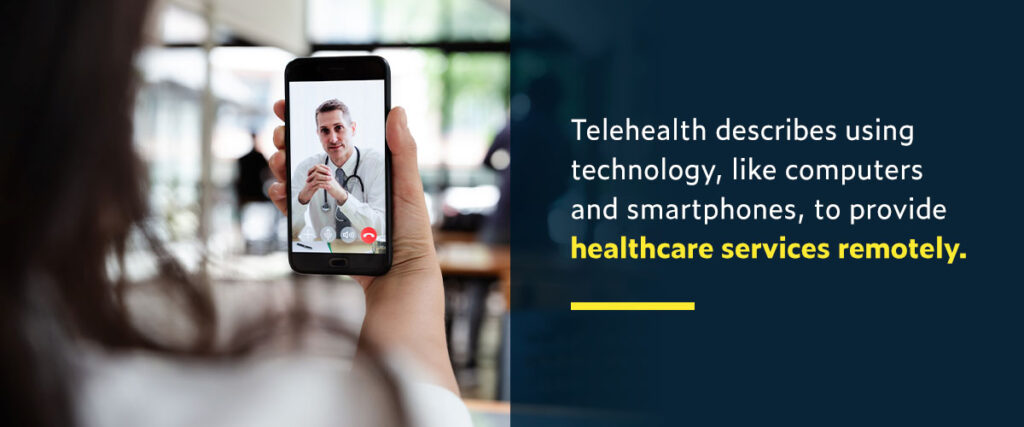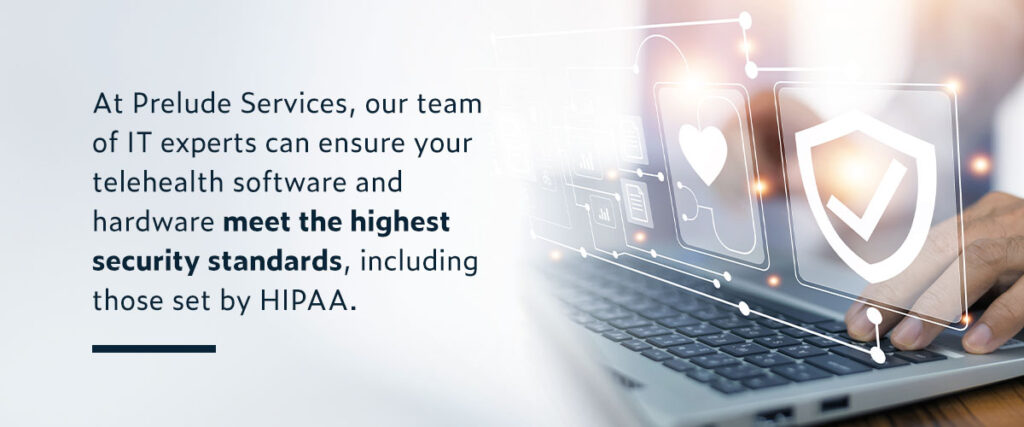
Telehealth and telemedicine may be used interchangeably, but they’re not the same. Telehealth is a general term that covers a range of clinical and non-clinical services. Telemedicine, on the other hand, specifically refers to medical diagnosis and treatment. Both describe healthcare services delivered virtually.
In a broad sense, telehealth allows patients to receive care, manage their health and communicate with providers without leaving their homes. This comes with many benefits, such as:
- Reduced exposure to germs.
- Greater convenience.
- More access to medical and mental health care.
For the above reasons and more, telemedicine and telehealth have become vital in general healthcare settings and senior living communities.
Let’s explore the differences between telehealth and telemedicine and how to offer virtual care to your patients.
Do you need assistance implementing telehealth technology in your organization? Contact us — we can help.
What Is Telehealth?

Telehealth describes using technology, like computers and smartphones, to provide healthcare services remotely. It’s also called telehealth when a doctor communicates medical information online. Many activities describe telehealth, including:
- Delivering clinical care via video or audio calls.
- Educating patients about health with a video.
- Monitoring patients remotely.
- Sharing test results and images in email.
- Providing mental health counseling through chat messaging.
- Offering online patient intake forms.
Telehealth also includes non-patient functions, like virtual staff training and meetings. For instance, holding a live video meeting with nursing staff is a way to use telehealth technology.
Unlike in-person interactions, telehealth is typically delivered through:
- Phone
- Videoconferencing
- Chat
- Remote monitoring devices
- Patient portals
Imagine a patient meets with their doctor over Zoom from their personal computer. They’re participating in telehealth, or more specifically, telemedicine — more on that below.
Another example is if a patient emails X-rays to a dentist or completes their medical history online. Telehealth lets them convey this information without stepping foot in an office.
Telehealth also encompasses the data physicians exchange electronically. For instance, a physician may meet with a specialist virtually to get input about a patient’s condition or test results. Sharing patient information at lightning speed allows doctors to coordinate care quickly.
Telehealth is convenient for anyone wanting to receive healthcare without being in a particular location. Healthcare providers also benefit from the convenience of telehealth, enjoying time and cost savings.
How Is Telemedicine Different?
Telemedicine is a type of telehealth service. Unlike telehealth, which is used broadly, telemedicine refers only to clinical services such as:
- Diagnosing
- Testing
- Treating
Telemedicine does not refer to non-clinical services or those that do not involve any form of medical treatment. A patient exploring payment options with a social worker online would not be considered telemedicine, for example. By contrast, a doctor evaluating a patient over a video call would be an example of telemedicine that belongs under the telehealth umbrella.
Why Do These Differences Matter?
Whether you’re a physician or a patient, it helps to know the difference between telemedicine and telehealth for reimbursement purposes. Since telehealth is a broad term that covers everything from remote patient monitoring to online training, some telehealth services may not be covered by a patient’s insurance plan.
Patients need to know what their policy covers before engaging in telehealth services to avoid unexpected costs. Likewise, physicians and healthcare administrators need to understand what telehealth services they can bill insurance companies for and which ones they’ll need to ask for out-of-pocket payment.
It also helps administrators to explore telehealth as a whole and consider expanding services beyond telemedicine. For example, organizations might consider training their staff virtually versus conducting in-person courses or using telehealth to improve workflow and administrative tasks. They’ll have to think about what hardware and software they need to integrate various telehealth tools.
What Are the Pros and Cons of Telehealth and Telemedicine?
According to the American Medical Association (AMA), roughly 85% of physicians use technology to care for patients, and nearly 70% are enthusiastic about continuing to use it to save time and improve overall patient care.
As with all good things, telehealth does come with some limitations. Let’s review the pros and cons.
Advantages to Consider

Telehealth and telemedicine offer many benefits for physicians and patients. Healthcare administrators can also reap the rewards of virtual communications. Benefits include:
- Improved management of chronic illnesses: Patients who live with chronic conditions such as diabetes or heart disease no longer need to make in-person visits for checkups. Instead, telehealth lets doctors monitor patients through remote monitoring devices. They can also provide advice, change medications and help patients manage their conditions remotely.
- Increased access to care: Telemedicine lets doctors reach patients far and wide. No matter where a patient is located, whether in a rural community or across the country, they can meet with a physician online. Virtual appointments can be especially helpful to patients who can’t drive or have limited mobility. It removes the need to travel long distances for specialist visits, too.
- Fewer canceled appointments: Since patients don’t have to use transportation to make it to an appointment, physicians can expect fewer late arrivals and cancellations. It’s also easier to fit virtual appointments into a busy schedule without travel time — another reason to keep an appointment.
- Easy-to-use technology: The technology healthcare providers use to deliver telehealth services often involves simple interfaces. Patients and healthcare staff can learn how to use telehealth tools relatively quickly, regardless of age or background. For instance, according to a recent study, most older adults thought the technology implemented to complete a telehealth visit was very easy to use.
- Improved care continuity: Telehealth supports streamlined communication between healthcare providers. With telehealth technology like video conferencing, physicians can quickly hop into a virtual call with a specialist or consultant for guidance. This option helps doctors make quick and accurate diagnoses.
- Reduced exposure to illnesses: Since patients aren’t required to leave their rooms to see a doctor for a telemedicine appointment, they can expect reduced exposure to germs. Healthcare and administrative staff also experience less exposure to illnesses if they can provide services remotely.
- Lower costs: Telemedicine visits may cost less than in-person visits but can provide the same level of care. Physicians and administrators can expect cost savings, too, since telehealth aids with streamlined workflows and reduces the need for administrative support and physical space.
- Saved time: Patients can complete documentation tasks online with telehealth tools like patient portals. This means they’ll spend less time waiting in an office. Telehealth technology also provides easy scheduling, helping physicians and patients make appointments quickly and easily.
- Greater engagement: Patients with easy access to their medical records and data online may be more engaged with their treatment and health. The convenience of telehealth technology can also increase engagement and satisfaction among healthcare staff.
- Improved work-life balance: Physicians enjoy a better work-life balance with telehealth options. That’s because they have greater control over when and where they work and can optimize their schedules.
Disadvantages to Think About
Although telehealth technology has many advantages, it’s not appropriate for every situation and comes with some challenges. Patients, providers and administrators must weigh the pros with the following cons:
- Requires a reliable internet connection: Online activities, like joining a video conference, require a stable internet connection. Many patients do not have access to a dependable or affordable internet connection, especially if they live in a rural area. Internet connectivity is a major obstacle in delivering telehealth. More than a third of doctors say internet speed and access issues impact their ability to use telemedicine.
- Requires some technological know-how: Some patients do not own or know how to use computers, tablets or smartphones. However, there’s a workaround. Healthcare organizations can give patients the necessary devices and show them what to do.
- Not the best option for some patients: A patient may have a condition that makes it difficult to use telehealth. For example, vision or hearing impairments can make it challenging to communicate by phone or video. Caregivers might need to help with virtual appointments in these cases.
- Most patients prefer in-person services: Despite its convenience and other benefits, many patients still prefer in-person care. One study found that most patients over 65 like to see their doctor in person. Nevertheless, older patients are satisfied with telehealth services and appreciate the option.
- Not suitable for all situations: In some cases, for a patient with a complex health concern, it’s best for them to have an in-person visit. High-risk patients also need regular physical exams to avoid complications. Overall, it can be easier for providers to make a correct diagnosis with an in-person exam.
- May come with technological barriers: Factors like power outages or hardware malfunctioning can prevent or disrupt a telehealth session. Also, security breaches and Health Insurance Portability and Accountability Act (HIPAA) compliance could be an obstacle for some healthcare providers. IT service providers, like Prelude Services, can help healthcare organizations ensure they use compliant technology.
- May not be covered by insurance: Although coverage for telehealth services has expanded in recent years, some services may not be covered by a person’s insurance. State and federal laws are also constantly changing. While an insurance company may cover a telehealth service today, they may not cover it tomorrow.
What Does Implementation Entail?
Whether you manage a family medicine practice or are an administrator at a senior living community, telehealth is essential. Patients must know they can get care when they need it. Telehealth is a tool to bring them care around the clock, wherever they are.
Any healthcare provider can implement some form of telehealth. It all begins with a plan. The following provides an overview of the implementation steps:
1. Identify Opportunities to Improve
The first step to implementing telehealth is identifying opportunities to improve patient care and satisfaction. For instance, consider if patients typically spend too much time waiting for appointments. Can telehealth options, like a secure patient portal, help patients complete forms faster and get seen by doctors in less time?
Also, consider workflow needs and look for inefficiencies. Think about how telehealth technology can speed up communication between employees and other physicians and improve workflow overall.
2. Consider How You’ll Deliver Telehealth Services
After identifying issues, think about the tools you’ll use to help solve these problems. There are different categories of telehealth to consider:
- Synchronous: Synchronous telehealth refers to real-time interactions between a patient and a provider. This form of telehealth requires hardware and software that lets you hold video and audio meetings.
- Asynchronous: Asynchronous telehealth is when patients and doctors exchange information at different times. An example of asynchronous telehealth is if a patient emails test results and their doctor reviews them later. To offer asynchronous telehealth, you’d need a tool like a HIPAA-compliant email service. Giving patients remote monitoring devices, like glucose meters or oximeters, is also a form of asynchronous telehealth.
3. Learn the Rules
Implementing telehealth requires compliance with various state and federal laws. For instance, healthcare providers must use technology that complies with HIPAA regulations, such as the Privacy Rule and Security Rule. At Prelude Services, our team of IT experts can ensure your telehealth software and hardware meet the highest security standards, including those set by HIPAA.

4. Build an Implementation Team
Successful telehealth implementation requires teamwork. Determine who will play a role in the implementation and their duties. Include individuals in financial, technological, administrative, leadership, legal and clinical roles.
If you choose to outsource part or all of your IT operations, let us know. We can help you reach your telehealth implementation goals, whether you need cybersecurity protection or assistance finding the right tools. Our team can also offer support if you experience any technology issues.
5. Gather Resources
There are many resources available to help you and your team implement telehealth. For instance, the Health Resources and Services Administration built Telehealth.HHS.gov to help healthcare providers offer or expand telehealth services. The AMA also created a Telehealth Implementation Playbook to help practices adopt telehealth and integrate digital tools into their workflows and patient care.
How Prelude Services Can Help
Telehealth is here to stay and will continue to evolve. Whether you’re just starting with telehealth or need to enhance your current systems, we can help you get on board.
We are a managed service provider compliant with Service and Organization Controls. We’ll prioritize your patients’ data safety and offer secure solutions that your IT needs. Our services include:
- 24/7 support desk
- Security management
- HIPAA risk assessment
- Hardware and software support
- Cloud computing
- Enterprise reporting
- Network management
Contact us today to learn more about our IT services and how we can help you implement telehealth compliantly and efficiently.

CONTACT PRELUDE SERVICES FOR 24/7 IT SUPPORT
Technology has become a crucial part of the modern business experience. Without functional computers and mobile phones, many business practices would grind to a halt. Unfortunately, breakdowns and malfunctions are an inevitable part of any machine, meaning businesses do grind to a halt until the issues are fixed. In order to keep your business running, it's crucial to have access to IT support when you experience technical difficulties.
If you're a healthcare company, long-term care provider, or small business in need of IT support at all hours, consider Prelude Services. We're a SSAE SOC
Compliant business dedicated to improving your security and functionality. We offer specific IT services for senior living care, nursing homes, retirement home services and assisted living, including 24/7 IT support. If you want to know how Prelude can help you, contact us today!
